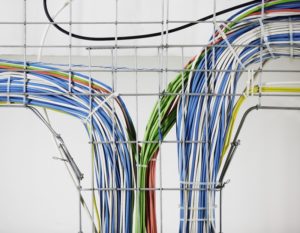
Underground cabling places fiber-optic cables out of sight and protects people from safety risks.
When installing new power lines and utility cables, you have two choices: underground cabling or aerial cabling. Unless specific conditions prevent you from doing so, underground cabling is often the more beneficial choice for your cable installation. Read on to learn precisely what underground cabling refers to, and why it is considered to be the preferred choice for cabling installations.
What is Underground Cabling
Simply put, underground cabling refers to cables installed and buried below the ground. These cables which distribute electrical power and communications are buried underground rather than suspended overhead as aerial cables several meters aboveground. Downtown areas with tall buildings often require underground cabling, as underground cables are less exposed and therefore less dangerous than overhead cables, as well as less of an eyesore.
Underground Cabling Requires Less Space
Aerial power and communications lines take up a lot of space, as they require poles to hold them aboveground and as the cables take up space alongside buildings and trees.
Underground cables are popular in densely populated areas where space is precious. Additionally, when installed underground, cables require a narrower band of land than aerial cables would require.
Less Visual Impact
Aerial cabling can easily obstruct a property’s view as well as diminish the curb appeal and overall value of a property, whether that be a home or a business. Underground cabling ensures that the cables are completely out of sight and unobtrusive to any property.
Less Exposure to Damage
By being exposed to the elements and nature, aerial cables are more vulnerable to damage. A tree branch could fall, a car could hit the poles, heavy snowfall can weigh the cables down, or a squirrel could chew on the wires. Risking this damage means you also risk facing costly repairs and upset customers with no power or communications in their buildings. Underground cabling is the best choice for ensuring that your cabling will work regardless of weather conditions or unpredictable events.
Less Dangerous
Damaged aerial power lines pose a safety risk to anyone near them. The cables could collapse onto nearby cars or buildings, and downed power lines can cause powerful electric shocks to anyone who gets too close. Underground cables, because they are less susceptible to damages and are not as easily accessible to people, do not pose as many risks.
Get in Touch with FiberPlus
FiberPlus has been providing data communication solutions for over 25 years in the Mid Atlantic Region for a number of different markets. What began as a cable installation company for Local Area Networks has grown into a leading provider of innovative technology solutions improving the way our customers communicate and keeping them secure. Our solutions now include:
- Structured Cabling (Fiberoptic, Copper and Coax for inside and outside plant networks)
- Electronic Security Systems (Access Control & CCTV Solutions)
- Wireless Access Point installations
- Public Safety DAS – Emergency Call Stations
- Audio/Video Services (Intercoms and Display Monitors)
- Support Services
- Specialty Systems
- Design/Build Services
FiberPlus promises the communities in which we serve that we will continue to expand and evolve as new technology is introduced within the telecommunications industry.
Have any questions? Interested in one of our services? Call FiberPlus today 800-394-3301, email us at info@fiberplusinc.com, or visit our contact page. Our offices are located in the Washington, DC metro area, Richmond, VA, and Columbus, OH. In Pennsylvania, please call Pennsylvania Networks, Inc. at 814-259-3999.
Do you enjoy clicking “Like” and “Follow?” Be sure to click on our official Pinterest, Facebook, Twitter, and LinkedIn pages today!
This entry was posted on Wednesday, December 4th, 2019 at 3:55 pm . You can follow any responses to this entry through the RSS 2.0 feed. Both comments and pings are currently closed.